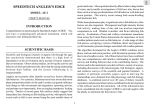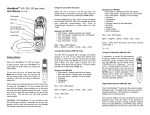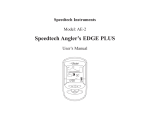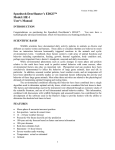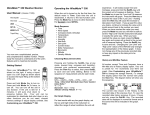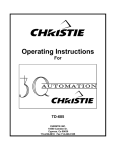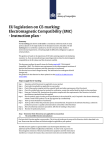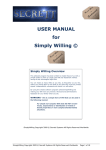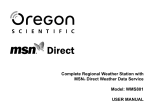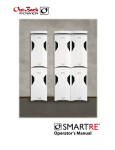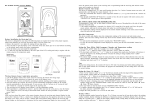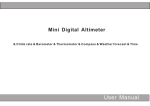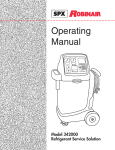Download ME-1 Mariners Edge - Laylin Associates
Transcript
Speedtech Instruments Model: ME-1 Speedtech Mariner’s EDGE User’s Manual INTRODUCTION DISCLAIMER Speedtech’s Mariner’s EDGE is a handheld precision instrument which tracks tide heights and times, sun and moon positions, barometric pressure, and predicts fish feeding activity based on those measurements. The tide prediction is based on known data such as sun and moon positions, along with each port’s specialized “harmonic code”. Local weather conditions can greatly affect tide heights, including air pressure changes and wind force. Accuracies of tide data from the Marnier’s EDGE are within 15 minutes and 1 foot, when compared to printed charts. HOWEVER, actual tide depth can vary. FEATURES • Present fish feeding activity, 1-10 • 4-hr future fish feeding activity forecast • 96-year fish feeding activity based on future sun and moon information • Tide height and times • Tide data for 2003 -2099 • Barometric pressure with 24-hr history • Sunrise, sunset times • Moon phase and position • Weather forecast based on air pressure • EL backlight The Mariner’s EDGE has a port listing of 546 locations. The locations are for the US, including Alaska, Hawaii, Cuba, Honduras, and other select locations. Due to international laws, the Mariner’s EDGE does not cover Canada or other countries at this time. The full port listing is shown on the separate pages, listed in order by state. SCIENTIFIC BASIS OF FISH FEEDING FORECAST Anglers and scientists alike identify several key factors affecting fish behavior. For centuries, fishermen have been aware that moon phase and position relative to the earth’s surface can greatly influence feeding activity. Details of record game fish catches clearly suggest that lunar phase has a bearing on fish feeding activity, with specific lunar events such as full or new moons being the most notable times of good catch rates. This activity occurs among both ocean-dwelling and freshwater fish. The time of day and sun position are important components as well. Weather is another vital factor affecting fish activity. Evaluations of bass and walleye tournament summaries from across the United States demonstrate the importance of local weather patterns and events on fish behavior. A wide range of other fish species, occupying a variety of habitats, detect and respond to barometric pressure changes associated with weather patterns. The algorithm developed for the Mariner’s EDGE combines moon phase, and sun and moon position, with barometric pressure effects. All of these factors have been combined into one comprehensive relationship to predict fish feeding activity. The factors used in the instrument were derived from a variety of sources, including discussions with meteorologists, fish biologists, anglers, and extensive surveys of the scientific and popular literature. A combined total of over 40 years of fishery research experience and personal observations contributed to the development of the software used in the instrument. All of this information has been consolidated into the Mariner’s EDGE to provide anglers with the ability to determine the best times to fish. INITIAL SET UP Two CR2032 Lithium button-cell batteries are included with your Mariner’s EDGE. 2. Using the provided small screwdriver, remove the battery cover and insert the batteries (positive side facing up), closing the cover. Be sure to seat the rubber gasket properly (this may take some patience). 3. Follow the SETUP guide to set the time, date, coordinates and other settings. 1. BASIC OPERATION Refer to FULL OPERATION for detailed instructions. 1. Press and hold the MODE button for 2 seconds to turn on (and off). 2. Press the TIME button to switch between present and future modes. 3. Press the MODE button to cycle through each screen of information 4. Press and hold the SET button for 2-seconds to enter programming mode. Press the SET button while in PORT NAME mode to change the port. 5. Press and hold the TIME button for 2-seconds to activate/deactivate the button lock. 6. Press the SET button briefly to turn on backlight for five seconds. Note: There will be a delay from scrolling from the sunset to port name mode, during which time the LCD will show a progress bar. DISPLAY (NON-TIDE MODES) DISPLAY (TIDE MODES) A. Present fish feeding activity, 1-10 bars A. Present fish feeding activity, 1-10 bars B. 4-hour future activity (24-hour forecast in B. Port name or 24-hour tide chart the future time mode) C. Weather forecast (on present mode only) C. Weather forecast (on present mode only) D. Moon phase D. Moon phase E. Sun and moon position E. Sun and moon position F. Tide data F. Time (this will change when the MODE button is pressed) -- SETUP PROCEDURES -INFO NECESSARY FOR SETUP Proper set-up requires the local time and date, time zone (hours from GMT), latitude and longitude (in degrees and minutes), and altitude. The Mariner’s EDGE requires sun and moon positions, which are derived from latitude, longitude and time zone. Barometric pressure also affects fish behavior, and the correct altitude must be entered to establish the correct relative air pressure. IMPORTANT (please read): The tide data is derived from the local port name. When a port name is entered, the latitude, longitude, and time zone are automatically set. Changing any of that information will result in the deletion of the port name. The Mariner’s EDGE can have TWO ports set; one in the “present” mode, and one in the “future” mode (which can be set to the present time and date). There are cases when the location desired for fishing is different than a location for tides. To have the most accurate of both, it is recommended to set the present mode to the desired fishing coordinates, and the desired port in the future mode. TIME ZONE The time zone setting is based on the deviation from GMT (Greenwich Mean Time). If your location follows Daylight Saving Time (DST), the resulting time zone must be increased by one during this time (summer time). North American Time Zones: Atlantic Time -4 (-3 during DST) Eastern Time -5 (-4 during DST) Central Time -6 (-5 during DST) Mountain Time -7 (-6 during DST) Pacific Time -8 (-7 during DST) Alaska Time -9 (-8 during DST) Hawaii Time -10 (-9 during DST) degrees entry, and multiply the decimal by 60 to calculate the minutes. For example, 35.407° The correct latitude and longitude is necessary is 35 degrees, and 24 minutes (.407 x 60). for proper sun and moon information. The Note: the continental US lies within Latitudes correct altitude is required for proper adjustment of air pressure. When a port name N25° to N49° and longitudes W67° to W123°. is set, the latitude, longitude, and time zone will automatically be set; thus you may skip For locations in Canada, use the website www.nrcan-rncan.gc.ca. For locations outside this step. To locate local latitude, longitude of North America, use www.mapquest.com or and altitude, refer to a GPS unit, local airport, www.world-gazetteer.com. Note that the or the internet. The easiest online source is Mariner’s EDGE will not display tides other www.topozone.com. Choose “Get a Map” and than for US locations. enter in your town and state. In the “Place Name Search”, it will show elevation in feet If there is trouble accessing your local and latitude/longitude as a decimal. Double click on the town name and a map will appear. coordinates, please e-mail Speedtech at At the bottom of the map, select D/M/S. Then [email protected] for assistance. look above the map for latitude/longitude in degrees/minutes (pay attention to the direction as well; North/South and West/East). LATITUDE, LONGITUDE, ALTITUDE If you know the latitude/longitude in decimal degrees only, use the whole number for the DETAILED SETUP If unit is off, press and hold MODE button for two seconds to turn ON. There is a set-up for the present mode and for the future mode, depending on which mode the unit is in when the programming mode is entered (press the TIME button to switch modes). It is best to set the present mode settings first. 1. Press and hold the SET button for two seconds to enter the set-up mode (skip to #2 if setting future mode); “12Hr” will flash. Press the – or + button to select 12Hr (AM/PM) or 24Hr (“military” time). Press SET button to confirm. 2. The hour will flash. Press the – or + button to set the current hour (note AM or PM if in 12Hr mode). Press the SET button to confirm. 3. The minutes will flash. Press the – or + button to set the current minute. Press the SET button to confirm. 4. The month will flash. Press the – or + button to set the current month. Press the SET button to confirm. 5. The day will flash. Press the – or + button to set the current day. Press the SET button to confirm. 6. The year will flash. Press the – or + button to set the current year. Press the SET button to confirm. Skip to 9 for future mode. 7. (Present mode only) The pressure unit (inHg or mb) will flash. Press the – or + button to select inHg or mb. Press the SET button to confirm. 8. (Present mode only) The altitude unit will flash. Press the – or + button to select ft or m (meters). This is for the altitude input for pressure adjustment, and tide heights. Press the SET button to confirm. **If a port has already been selected, the correct latitude, and longitude will be programmed. Changing these values will clear the port selected. The correct time zone will also be programmed, however during daylight saving time it is necessary to advance by one. 9. The time zone will flash. Press the – or + button to set the local time zone. Press the SET button to confirm. 10. The latitude direction will flash. Press the – or + button to set N (North) or S (South). Press the SET button to confirm. 11. The latitude degrees will flash. Press the – or + button to set the latitude degrees. Press the SET button to confirm. 12. The latitude minutes will flash. Press the – or + button to set the latitude minutes. Press the SET button to confirm. 13. The minutes will flash. Press the – or + button to set the current minute. Press the SET button to confirm. 14. The longitude direction will flash. Press the – or + button to set W (West) or E (East). Press the SET button to confirm. 15. The longitude degrees will flash. Press the – or + button to set the longitude degrees. Press the SET button to confirm. 16. The longitude minutes will flash. Press the – or + button to set the longitude minutes. Press the SET button to confirm. 17. (present mode only) The altitude compensation will flash. Press the – or + button to set the local altitude (in feet or meters, as selected in step 8). Press the SET button. The set up is now complete. Please refer to the “TIDE FUNCTION” instructions to set the port name. Note: If you press once, each step goes as 1 meter; if you hold + or –button for 2secs, if will go fast forward or backward. Note: the future time and date can only be set for a time and date in the future or current time and date. If a past time and/or date is set, the time and date will default to the current set time and date. The future mode will allow for a different port name to be entered. -- OPERATION AND FEATURES -DISPLAY MODES Press the MODE button to scroll through information, in either present or future modes; no pressure will display in future mode. TIME → DATE → YEAR → PRESSURE → SUNRISE → SUNSET → PORT NAME → TIDE HEIGHT RANGE → HIGH TIDE HEIGHT AND TIME (alternating when two high tides exist) → LOW TIDE HEIGHT AND TIME (alternating when two high tides exist) →TIME When in pressure mode, the graph at the top will display 24-hour history. When in tide modes, the graph at the top will display 24-hour for that day tide height, as a percentage of the total tide height. The display will revert to the time display if no buttons are pressed for one minute and will turn off when no button is pressed for five minutes (all settings remain, and air pressure is still tracked). TIDE FUNCTIONS Speedtech’s Mariner’s EDGE has 546 ports stored internally. While there is no option to add more ports once a unit has been made, every effort has been made to include the most significant ports around the US. PORT NAME (SEE LIST ATTACHED) The following can be done in both present and future modes. 1. Press and release the MODE button until the PORT name mode is displayed (there will be letters or dashes in the top section). 2. Press and hold the SET button for two seconds. The first alpha-numeric code will show a flashing underline. 3. Press the – or + button to scroll through the available letters or numbers. Note that the letters cannot be set to any letter, only for those listed. Press the SET button to confirm the first letter. 4. Press the – or + button to scroll through the available letters or numbers. Press the SET button to confirm the second letter. 5. Press the – or + button to scroll through the available letters or numbers. Press the SET button to confirm the third letter. 6. Press the – or + button to scroll through the available letters or numbers. In some cases the last letter cannot Press the SET button to confirm the fourth letter. TIDE MODES By pressing the MODE button, the Mariner’s EDGE will scroll through the tide information screens in sequence. STATUS BAR TIDE RANGE There may be a short delay when the Mariner’s EDGE enters the tide mode. This will occur when a date change has occurred, or a different port is selected. The status bar will display at the top. RANGE PORT NAME The first screen displays the PORT name setting, along with the current time. The upper section will display the 24-hour future tide height, as a percentage of highest tide height. In the TIDE RANGE mode, the total tide range will be displayed in feet or meters. This is the lowest tide height subtracted from the highest tide height; thus the range will not necessarily be the highest tide (for example, a high tide of 8.4 m and a low tide of 1.0 m is a tide range of 7.4 m). HIGH TIDE HEIGHT AND TIME OTHER TIDE FUNCTIONS In tide modes, the fish feeding forecast for the current time is displayed (whether in present or future mode), on the right side of the LCD. The The display will show the time of the high tide, moon phase and sun and moon position are on the left side, and the height of the high tide, displayed also. The weather forecast icon is on the right side, for the next 24-hour period. displayed in present mode only. In many areas there are two high tides in a 24hour period, and this display will alternate The future mode operates in a similar manner between the two times; take note in AM or PM, to the present mode. In future mode, the set unless military time is used. time can be scrolled ahead or backward hourby-hour, across dates (from 11PM to 12AM). LOW TIDE HEIGHT AND TIME The future time and date can actually be the same as the present time and date, which allows two ports to be accessible easily. The display will show the time of the low tide, on the left side, and the height of the low tide, on the right side, for the next 24-hour period. In many areas there are two low tides in a 24hour period, and this display will alternate between the two times; take note in AM or PM, unless military time is used. FISH FEEDING FORECAST The unique feature of Speedtech’s Mariner’s EDGE is the fish feeding prediction. The graph on the right side of the LCD displays the present fish feeding activity level, on a scale from 1 (low) to 10 (high). In present mode, this is for the current time; in future mode, this is for the set time and date. MEDIUM LOW HIGH FISHING FISHING FISHING ACTIVITY ACTIVITY ACTIVITY The graph at the top of the LCD (except when viewing air pressure) shows the future fish feeding activity. The current level is displayed as “0 Hr” on the left. In present mode, the activity is for the next four hours; for future mode this is for the next 24 hours. Present 4-hour graph: Future 24-hour Graph Note that the “future” mode may be set for any time and date through 2099, including the current time. The fish feeding activity based on sun/moon position only. FUTURE MODE FEATURES BAROMETRIC PRESSURE The built-in barometer senses the changes in air pressure every 15 minutes, even when the unit is “off”. When viewing the current air pressure, the chart on the top of the LCD will display the air pressure history for the past 24 hours. Each column, right to left, represents one hour in the past. Each dot represents a When the time is scrolled to a different time, change in air pressure, up or down, relative to the tide information will also track, once the the current air pressure, or “0 Hr”. To read the MODE button is pressed to view those screens. graph, follow the chart from left to right. The Note that the time cannot be scrolled when in graph will increase when the air pressure rose, PORT NAME mode. and decrease when the pressure fell. The pressure trend for the past 6 hours is the most If the future time and date is equal to the current time and date, it will track along. This useful for short-term weather forecasting. feature is good for planning shorter-term fishing plans, over the next 24 hours. When viewing the time in future mode, the – and + buttons can be pressed to scroll ahead or backward hour-by-hour. The time scrolled to will remain set. This is useful for preparing for a future fishing trip and planning the best times to fish. No weather prediction or barometric pressure can be viewed when in future time mode. WEATHER FORECAST SEVERE WEATHER WARNING The Mariner’s EDGE measures changing air pressure and predicts short-term changes in weather over a small area. In general, falling air pressure results in worsening weather, and rising air pressure results in fairer weather. Rapidly falling pressure signals an approaching storm, while rapidly rising pressure will result in strong winds. The weather forecast is for the next 6 to 12 hour period, over an area of 20 to 30 miles. The accuracy of any pressure-based forecast is about 75%, although less in areas where pressure does not affect weather as much. By definition, severe weather occurs when barometric pressure changes by 6 millibars (up or down) during a three hour period. Severe weather, including wind and rain, generally accompanies falling barometric pressure. Rising pressure will result only in high winds. SUNNY PARTLY CLOUDY CLOUDY RAINY When severe weather is detected, the unit will give an audio warning and flash the weather icon. The alarm is muted by pressing any button. The alarm functions and will sound, even if the unit is off, unless this feature is disabled. To disable the severe weather warning, press and hold the – button for three seconds while in present mode. A beep will sound once. To activate the alarm, press and hold the + button for three seconds while in present mode. A series of three beeps will sound. MOON PHASE The moon phase is indicated in eight symbols, as shown below. The moon phase is for either the present date, or for the set future date, depending on which mode is viewed. New moon Waxing crescent First quarter Waxing gibbous Full moon Waning gibbous Last quarter Waning crescent The exact sunrise and sunset times can be located by pressing the MODE button and cycling through the modes, in either present or future mode. W E MOON RISE W E SUNRISE W E W MOON OVERHEAD W E SUN OVERHEAD E MOON SET W E SUNSET W E MOON UNDERFOOT W E SUN UNDERFOOT NOTE: If the sunrise and sunset times (also sun/moon position) appear to be off by an hour, SUN AND MOON POSITIONS check to be sure the correct time zone is set, A useful feature of the Mariner’s EDGE is the taking into account daylight saving time. If it chart displaying sun and moon positions. Once appears to be off by more than an hour, check understood, the current positions of the sun and the Lat(itude) and Lon(gitude), including the direction.. In the US, Lat should be N(orth) moon can be determined at a glance. The center circle represents the earth, with the sun and Lon is W(est). and moon revolving from East (rising) to West (setting). KEY LOCK BELT CLIP, CARRY POUCH The buttons may be locked to prevent accidental changes. Press and hold the TIME button for two seconds to activate/deactivate the key lock. A belt clip (which can also be used as a mounting bracket) is attached and can be removed if desired. A carry pouch is also included to protect the unit from the elements. CONDITIONS AFFECTING ACCURACY MAINTENANCE When the unit is subjected to a change in altitude, which can occur when ascending or descending a building or when traveling across uneven terrain, the pressure readings are affected. Since the present fish feeding prediction, weather forecast, and severe weather alarms rely on changing air pressures, those readings should be ignored until the altitude has been steady for two to three hours. Also be sure to set the altitude adjustment to the current altitude (if known). The Mariner’s EDGE is designed to withstand moderate elements, but like most electronic devices should be handled carefully to avoid damage. Do not submerge in water. WARRANTY Speedtech’s Mariner’s EDGE is warranted against manufacturing defects for one-year. This does not cover physical damage as a result of misuse. Please refer to the instructions or contact us for answers and assistance. Speedtech Instruments 45449 Severn Way #165 Sterling, VA 20166 703-430-8055 703-430-8066 (fax) 9:00 – 5:00 pm EST, M - F [email protected] www.speedtech.com



















